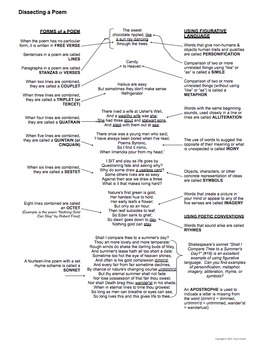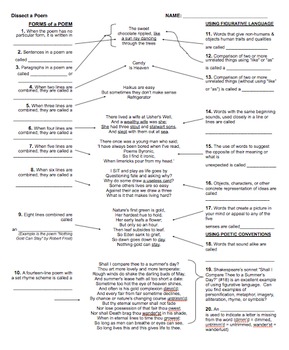Dissect a Poem: Complete Anatomy of Poem Activity EDITABLE
Tracee Orman
38.9k Followers
Grade Levels
7th - 12th, Higher Education, Homeschool
Subjects
Resource Type
Standards
CCSSRL.7.5
CCSSRL.8.5
CCSSRL.9-10.5
CCSSRL.11-12.5
CCSSL.7.5
Formats Included
- Zip
- Google Apps™
Pages
6 pages
Tracee Orman
38.9k Followers

Includes Google Apps™
The Teacher-Author indicated this resource includes assets from Google Workspace (e.g. docs, slides, etc.).
Description
Dissect a Poem: Complete Anatomy of a Poem Activity - Editable in Microsoft Word
This IS included in my mega bundle: ALL of my POETRY RESOURCES GROWING BUNDLE.
This exercise breaks down the different types of poems, parts of a poem, figurative language, and translation. Easy to read and understand, with plenty of examples. Teacher's guide included.
Updated: Differentiated student handouts with blanks now included AND Microsoft Word (both .doc and .docx formats) student copies, so you can customize to suit your student's needs.
This IS included in my first poetry pack Digital Poetry Resources Bundle, Volume 1.
You may also like:
Poetry Resources Bundle, Volume 2
This IS included in my mega bundle: ALL of my POETRY RESOURCES GROWING BUNDLE.
This exercise breaks down the different types of poems, parts of a poem, figurative language, and translation. Easy to read and understand, with plenty of examples. Teacher's guide included.
Updated: Differentiated student handouts with blanks now included AND Microsoft Word (both .doc and .docx formats) student copies, so you can customize to suit your student's needs.
This IS included in my first poetry pack Digital Poetry Resources Bundle, Volume 1.
You may also like:
Poetry Resources Bundle, Volume 2
Total Pages
6 pages
Answer Key
Included
Teaching Duration
2 days
Report this resource to TPT
Reported resources will be reviewed by our team. Report this resource to let us know if this resource violates TPT’s content guidelines.
Standards
to see state-specific standards (only available in the US).
CCSSRL.7.5
Analyze how a drama’s or poem’s form or structure (e.g., soliloquy, sonnet) contributes to its meaning.
CCSSRL.8.5
Compare and contrast the structure of two or more texts and analyze how the differing structure of each text contributes to its meaning and style.
CCSSRL.9-10.5
Analyze how an author’s choices concerning how to structure a text, order events within it (e.g., parallel plots), and manipulate time (e.g., pacing, flashbacks) create such effects as mystery, tension, or surprise.
CCSSRL.11-12.5
Analyze how an author’s choices concerning how to structure specific parts of a text (e.g., the choice of where to begin or end a story, the choice to provide a comedic or tragic resolution) contribute to its overall structure and meaning as well as its aesthetic impact.
CCSSL.7.5
Demonstrate understanding of figurative language, word relationships, and nuances in word meanings.





